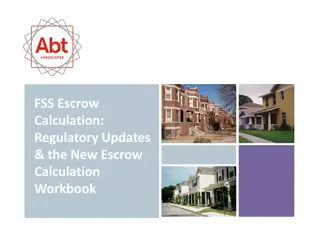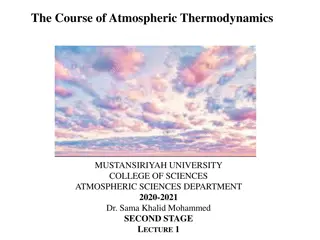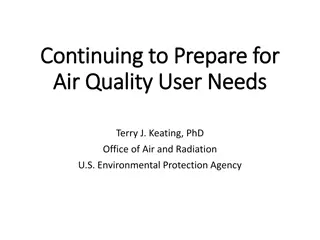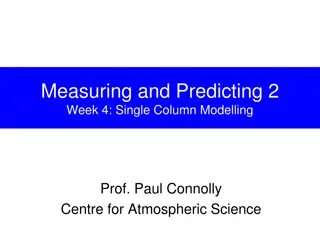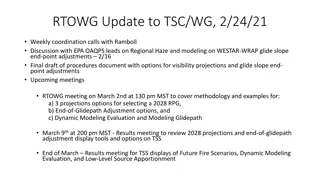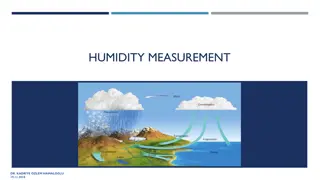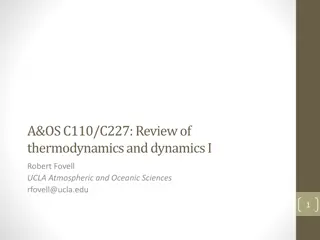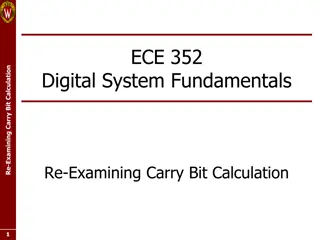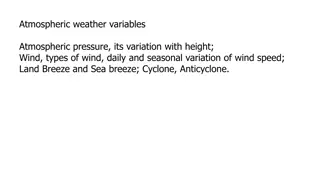Understanding CAPE and CIN Calculation in Atmospheric Modeling
Learn how to calculate Convective Available Potential Energy (CAPE) and Convective Inhibition (CIN) using the Weisman-Klemp sounding method. The procedure involves defining parcel properties, lifting the parcel level by level, and performing saturation adjustments. Explore the concepts of positive and negative areas in computing CAPE and CIN.
Download Presentation

Please find below an Image/Link to download the presentation.
The content on the website is provided AS IS for your information and personal use only. It may not be sold, licensed, or shared on other websites without obtaining consent from the author. Download presentation by click this link. If you encounter any issues during the download, it is possible that the publisher has removed the file from their server.
E N D
Presentation Transcript
Model Task #2: Calculating CAPE and CIN ATM 562 Fall 2021 Fovell (see course notes, Chapter 10) Last modified 9/22/21 1
Overview Given the Weisman-Klemp sounding on the model vertical grid constructed for MT1, compute CAPE and CIN. MT1 yielded mean , v, and as a function of height for the environment (denoted here with capitals instead of overbars as in the course notes). We will define a parcel and lift it, grid level by grid level, using parcel assumptions (parcel pressure = environmental pressure), adjusting the parcel if/when it becomes saturated. This will yield p, pv, qvp as a function of height, where subscript p indicates parcel. CAPE and CIN are computed using v, pv. 2
Procedure Define parcel properties ( p, qvp) at first real grid point above surface. Example problem: p = 300.52 K, qvp= 11.5 g/kg (parcel potential temperature about same value as environment, but parcel is a little drier, creating some negative buoyancy) Lift the parcel up one level, conserving the dry adiabatic quantities p, qvp. Compute parcel saturation mixing ratio qvsp valid for the new pressure and check relative humidity (RH). If saturated, perform isobaric saturation adjustment. Otherwise, parcel is unchanged. Lift to next level, conserving the dry adiabatic quantities even if parcel is already saturated. Compute qvsp and check RH. If saturated, perform saturation adjustment. Otherwise, parcel is unchanged. Continue on to model top. 3
On this figure, represents the parcel potential temperature, p Grid and concept 4
Saturation adjustment Parcel saturation mixing ratio is again a form of Tetens approximation over liquid If qvp > qvsp, then the condensation produced is C > 0 which means C < qvp qvsp, which is logical because as vapor condenses, heat is released, increasing the saturation mixing ratio. 5
Adjusted properties and CAPE The new adjusted parcel properties are And then CAPE uses 6
Computing positive and negative areas CAPE (and CIN) can be computed using the trapezoidal rule. For a given layer, we will have parcel buoyancy at the top and bottom of the layer, bk and bk-1. If both buoyancy values are positive, the positive area is simply Layers containing the LFC and EQL require special handling (see next slide). 7
Figure modified from Fig. 11.2 to match the specific example on next slide CAPE/CIN area concept Defining buoyancy b at scalar levels 8
Here, bk is the first layer with positive buoyancy, so bk-1 is negatively buoyant Layer with LFC For the model layer encompassing the LFC (zLFC is height where parcel buoyancy is zero and zk is height of layer top), the positive area is nominally : but zLFC can be linearly interpolated within the layer as so and 9
p = 300.52 K, qvp= 11.5 g/kg initial parcel Partial results (g=9.81 m/s2, Lv=2.5E6 J/kg/K) initial parcel potential temperature: 300.52 K initial parcel vapor mixing ratio: 11.50 g/kg z p thv_env thv_prcl qv_prcl CAPE CIN buoybot buoytop (km) (mb) (K) (K) (g/kg) (J/kg) (J/kg) (m/s^2) (m/s^2) 1.05 854.6 304.36 302.63 11.50 0.0 -26.6 -0.020 -0.056 1.75 786.5 305.76 306.00 10.15 0.3 -43.8 -0.056 0.008 2.45 722.7 307.36 309.51 8.78 27.0 -43.8 0.008 0.069 3.15 663.0 309.11 312.94 7.47 93.6 -43.8 0.069 0.122 3.85 607.2 310.97 316.29 6.23 194.9 -43.8 0.122 0.168 4.55 555.2 313.22 319.50 5.07 322.5 -43.8 0.168 0.197 5.25 506.8 315.64 322.51 4.01 466.0 -43.8 0.197 0.214 5.95 461.8 318.15 325.28 3.06 617.7 -43.8 0.214 0.220 6.65 420.1 320.73 327.73 2.24 769.5 -43.8 0.220 0.214 7.35 381.5 323.38 329.81 1.56 912.7 -43.8 0.214 0.195 8.05 345.7 326.11 331.50 1.03 1037.8 -43.8 0.195 0.162 8.75 312.7 328.97 332.77 0.64 1134.2 -43.8 0.162 0.113 9.45 282.2 331.90 333.67 0.38 1192.2 -43.8 0.113 0.052 10.15 254.2 334.88 334.26 0.21 1205.8 -43.8 0.052 -0.018 [ ] Vertically integrated CAPE 1205.8 J/kg CIN is -43.8 J/kg LFC detected at 1.67 km EQL detected at 9.97 km 10
Not CIN Plotted using metpy EQL CAPE LFC LCL CIN 11
MT2 assignment: Please turn in your code and output showing accumulated CAPE and CIN for each model level for the NZ=40, DZ=700 m setup from MT1. [see slide 10] [asking for a complete table of values, not a plot] 12
Notes and thought questions The example parcel starts with less vapor than the environment at the first scalar level, so the parcel buoyancy there is negative (not zero). This affects CIN calculation. CIN is only computed between the initial parcel level and the LFC, so don t include the negative buoyancy above the EQL. This result should be sensitive to resolution. What happens if you increase NZ and decrease z? This result is also sensitive to how the initial parcel is defined. What happens if you change the initial parcel properties? Do you think the CAPE and CIN would change a lot if you used a more accurate technique than the trapezoidal rule? For subfreezing conditions, a form of Tetens formula valid for ice might be used instead. How would this change CAPE? Soong and Ogura (1973, JAS) also try to account for how pressure changes along a moist adiabat, so their saturation adjustment is not strictly isobaric. Do you think that would make much of a difference? Comparison issues: (1) Some CAPE calculations do not include virtual temperature, which affects the results. (2) Alternatives to Tetens exist and affect calculations. 13
Use g=9.81 m/s/s instead Partial results (g=9.8 m/s2) initial parcel potential temperature: 300.52 K initial parcel vapor mixing ratio: 11.50 g/kg z p thv_env thv_prcl qv_prcl CAPE CIN buoybot buoytop (km) (mb) (K) (K) (g/kg) (J/kg) (J/kg) (m/s^2) (m/s^2) 1.05 854.7 304.36 302.63 11.50 0.0 -26.0 -0.020 -0.056 1.75 786.7 305.76 305.99 10.15 0.3 -43.0 -0.056 0.007 2.45 722.9 307.36 309.50 8.79 26.7 -43.0 0.007 0.068 3.15 663.3 309.11 312.93 7.48 92.9 -43.0 0.068 0.121 3.85 607.5 310.97 316.27 6.24 193.7 -43.0 0.121 0.167 4.55 555.5 313.22 319.48 5.08 320.7 -43.0 0.167 0.196 5.25 507.2 315.64 322.49 4.01 463.6 -43.0 0.196 0.213 5.95 462.2 318.15 325.25 3.07 614.6 -43.0 0.213 0.219 6.65 420.5 320.73 327.71 2.25 765.8 -43.0 0.219 0.213 7.35 381.9 323.38 329.79 1.57 908.4 -43.0 0.213 0.194 8.05 346.1 326.11 331.48 1.04 1032.9 -43.0 0.194 0.161 8.75 313.1 328.97 332.76 0.65 1128.8 -43.0 0.161 0.113 9.45 282.7 331.90 333.66 0.38 1186.5 -43.0 0.113 0.052 10.15 254.6 334.88 334.26 0.21 1200.0 -43.0 0.052 -0.018 [ ] Vertically integrated CAPE 1200.0 J/kg CIN is -43.0 J/kg LFC detected at 1.67 km EQL detected at 9.63 km 14






